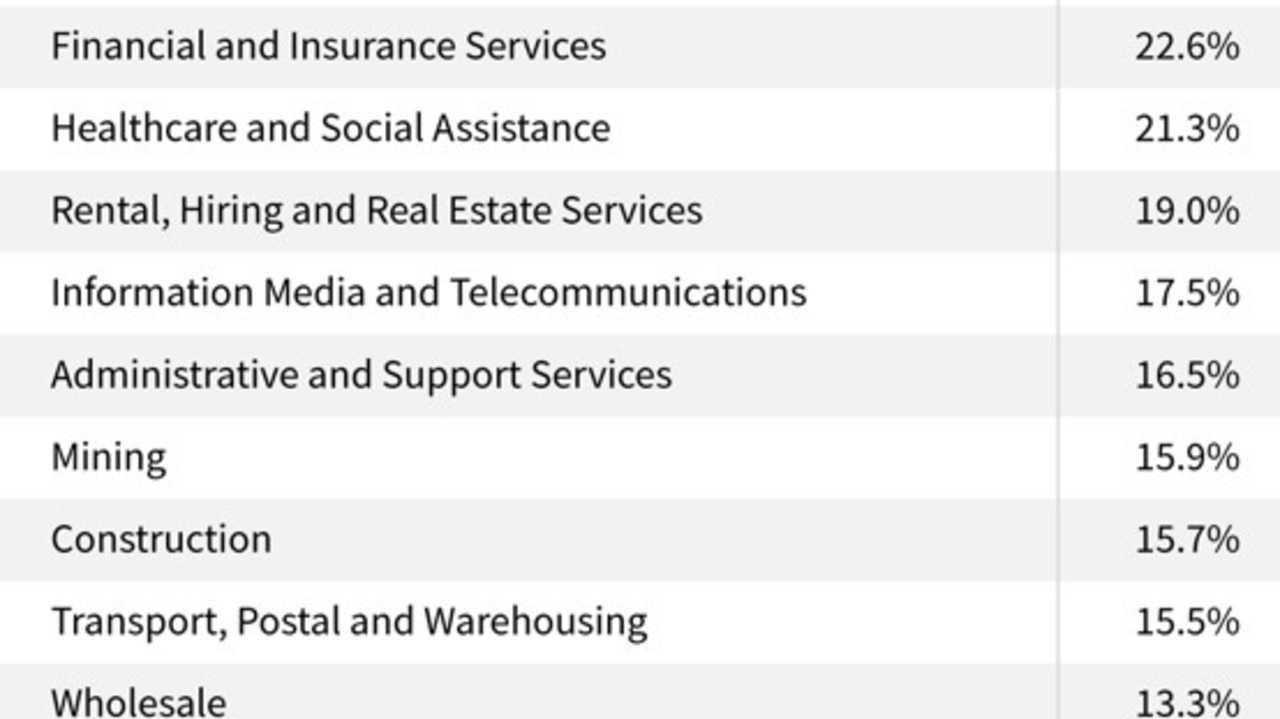
Figures by industry show one sector in particular has the worst record when it comes to paying their staff what they deserve.
Today marks an event in the calendar that no woman in Australia feels like celebrating.
Equal Pay Day, August 31, officially marks the 61 additional days from the end of the previous financial year that women must work on average to earn the same annual pay as men.
Yes, we’ve effectively worked the past 61 days for nothing when compared to our male counterparts.
Sadly, women have gone backwards during the Covid-19 pandemic – the gender pay gap widened by 0.8 per cent during the six months from February 2021 to August 2021.
The data, gathered from the Australian Bureau of Statistics (ABS) and released by Workplace Gender Equality Agency, has calculated the national gender pay gap stands at 14.2 per cent for full-time employees. This equals a difference of $261.50 per week between women and men.
The rise in the national gender pay gap was largely driven by a higher growth in men’s full-time wages (1.8 per cent increase) than women’s (0.9 per cent).
To add insult to injury, University of Sydney research shows that on average women have been expected to shoulder more of the burden of homeschooling and housework during the pandemic too.
Women reported doing an average of 61 per cent of household tasks, including home schooling, during the second week of July 2021, while their partners did 39 per cent.
State by state
The gender pay gap isn’t the same across all of Australia. Figures from May 2020 show that the ACT has the smallest gender pay gap at 8.1 per cent while WA has by far the biggest at 22.7 per cent.
People may say that this is because WA has mining, which is traditionally a male occupation. However, Equal Pay Day isn’t about getting the same pay for the same job.
It’s about women being valued equally in all work forces, women not being short-changed throughout their entire careers because they work in “female” industries. Women not ending up with substandard superannuation.
“There are, of course, many causes of inequity, including the distribution of senior roles and the number of women in management,” explains Jacqueline Graham, National President of Business and Professional Women (BPW) Australia.
“But to focus on pay inequity, the issue is not women are getting paid less for doing the same job as a man, it’s more that occupations which employ mostly women are paid less than those which employ mostly men.
“We value those who push a wheelbarrow more than those who push a wheelchair – as measured by pay packet.”
Gender pay gap by industry
When the full-time salaries of men and women are drilled down to by industry then the pay gap is a lot more prevalent in some sectors.
Professional, scientific and technical services industries are the worst offenders, while financial and insurance services are second. These jobs don’t easily fall under the “high risk” category, debunking the myth that men are paid more because their jobs are riskier.
Qualifications and the gender pay gap
Young girls are shown to outperform young boys in school and they take up 58 per cent of university places. Yet, only 18.3 per cent of CEOs are women.
What can be done?
Equal Pay Day isn’t just about shining a light on the injustice that still exists in Australia but it’s also about making a change.
“This Equal Pay Day, we’re calling on all Australians to ask #WhatsYourPayGap? in their workplaces and industries as a crucial step towards bridging this divide,” said WGEA Director Mary Wooldridge.
“Equal Pay Day is an ideal opportunity to remind employers around the country that one of the key levers of change is through gender pay audits. These audits help employers identify and address discriminatory pay, to ensure that women are equally compensated and valued.
“Research proves that regular audits close pay gaps faster.”
So while it’s just another thing that will no doubt fall on women (and some forward thinking men) to deal with, asking your employers to commit gender pay audits is the best way to celebrate this Equal Pay Day.
Once it’s out on the open, it’s much harder for employers to pretend the gender pay gap doesn’t exist.
Riah Matthews is the commissioning editor for news.com.au
https://news.google.com/__i/rss/rd/articles/CBMilwFodHRwczovL3d3dy5uZXdzLmNvbS5hdS9maW5hbmNlL3dvcmsvYXQtd29yay9lcXVhbC1wYXktZGF5LXdvbWVucy1zYWxhcmllcy1oYXZlLWdvbmUtYmFja3dhcmRzLWR1cmluZy1jb3ZpZC9uZXdzLXN0b3J5LzRkYmQ1YTQ1ZDYyYmNjNjhiMWUyMjE3NzdjY2RmYzFi0gGbAWh0dHBzOi8vd3d3Lm5ld3MuY29tLmF1L2ZpbmFuY2Uvd29yay9hdC13b3JrL2VxdWFsLXBheS1kYXktd29tZW5zLXNhbGFyaWVzLWhhdmUtZ29uZS1iYWNrd2FyZHMtZHVyaW5nLWNvdmlkL25ld3Mtc3RvcnkvNGRiZDVhNDVkNjJiY2M2OGIxZTIyMTc3N2NjZGZjMWI_YW1w?oc=5
2021-08-30 21:21:47Z
CBMilwFodHRwczovL3d3dy5uZXdzLmNvbS5hdS9maW5hbmNlL3dvcmsvYXQtd29yay9lcXVhbC1wYXktZGF5LXdvbWVucy1zYWxhcmllcy1oYXZlLWdvbmUtYmFja3dhcmRzLWR1cmluZy1jb3ZpZC9uZXdzLXN0b3J5LzRkYmQ1YTQ1ZDYyYmNjNjhiMWUyMjE3NzdjY2RmYzFi0gGbAWh0dHBzOi8vd3d3Lm5ld3MuY29tLmF1L2ZpbmFuY2Uvd29yay9hdC13b3JrL2VxdWFsLXBheS1kYXktd29tZW5zLXNhbGFyaWVzLWhhdmUtZ29uZS1iYWNrd2FyZHMtZHVyaW5nLWNvdmlkL25ld3Mtc3RvcnkvNGRiZDVhNDVkNjJiY2M2OGIxZTIyMTc3N2NjZGZjMWI_YW1w
Bagikan Berita Ini














0 Response to "Aussie industry with worst pay record - NEWS.com.au"
Post a Comment